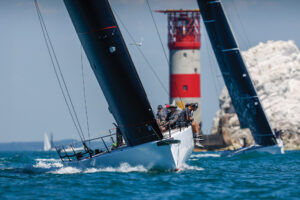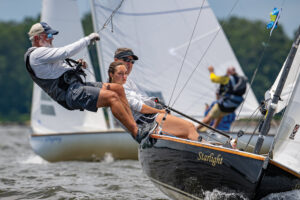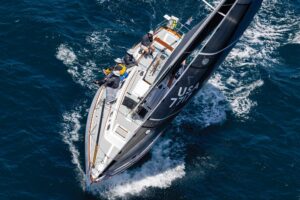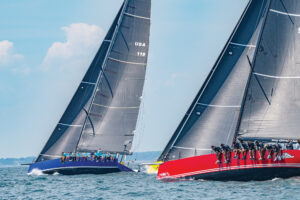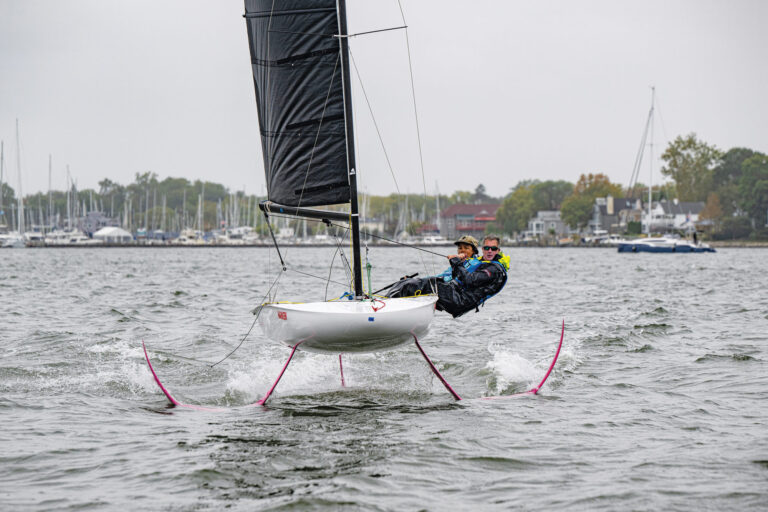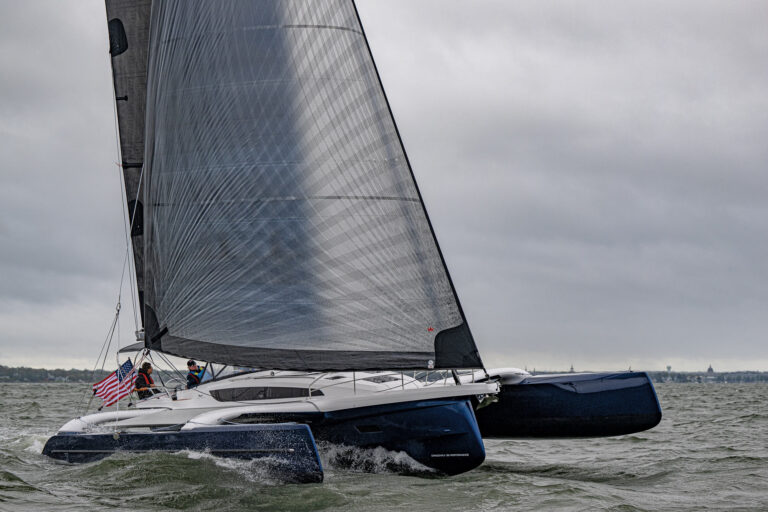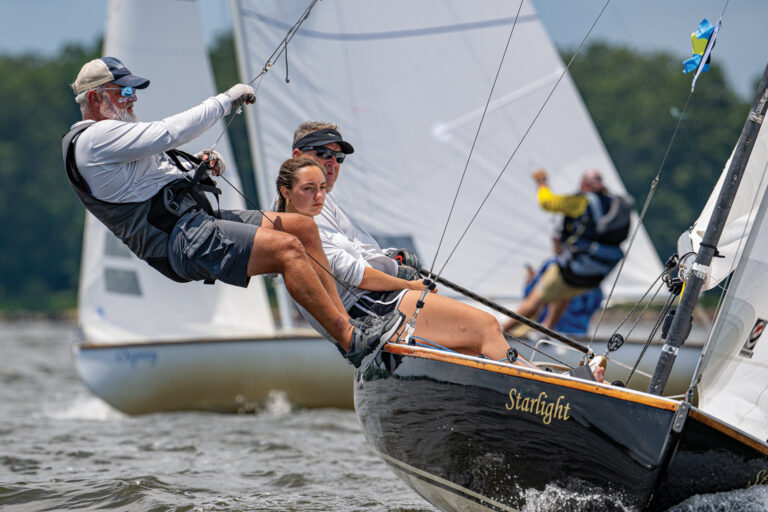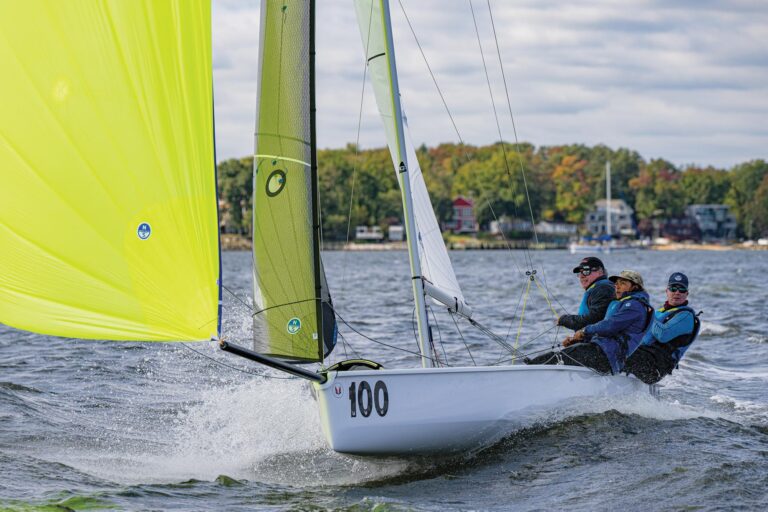
130509_AtlanticCup
Three years ago, the Atlantic Cup debuted with a bold plan: to bring a European-style doublehanded offshore racing series to America, and provide the top finishers with a cash prize. The first year of the regatta, 2011, drew a small fleet of mostly local boats. In 2012, the top European boats took notice, and 14 of the world’s best Class 40 teams converged on Charleston for a battle up the Atlantic Coast. Scheduling conflicts will keep most of the European teams on the other side of the Atlantic this spring—2012 Atlantic Cup winner Jorg Reichers just won the 1,000-mile Normandy Channel Race and American Emma Creighton’s Momentum Ocean Racing won last weekend’s RORC Cervantes Trophy—the 2013 Atlantic Cup has attracted a quality international fleet of seven boats to Charleston, S.C., to compete for $15,000 in cash prizes. Beginning on Saturday, May 11, the Cup will send the Class 40s to Newport, R.I., via New York City, culminating with an inshore series Memorial Day weekend off of Fort Adams in Newport.
Who Can Win?
Once again, this year’s Atlantic Cup has drawn the newest boat in the global Class 40 fleet to Charleston. _LeCoq Cuisine_, skippered by Eric LeCoq and Conrad Coleman, is a brand new Verdier design. In fact, the boat’s delivery from France to Charleston has been it’s longest sail so far! According to the designer, this is the fastest Class 40 to be designed yet, but the skill in making a Class 40 go fast is knowing the right times to add ballast and change sails. Can the co-skippers learn enough about their boat in time to compete against their more experienced rivals? If anyone can, it’s Coleman, who last year won the Global Ocean Race in a Class 40.
If experience matters, no team has more of it than Dragon. Led by Mike Hennessy and Rob Windsor, Dragon has been on an impressive global tour as of late, including a class win in the Pineapple Cup this past winter. Windsor is North America’s most experienced Class 40 sailor, with over 30,000 miles on these boats. It’s likely he has seen more of the boat than his family this winter, and experience goes a long way in ocean racing.
Another team with considerable experience is Icarus Racing_. The boat is on loan to Ben Poucher and Tim Fetsch from the Kings Point Foundation. For the past three years, these talented and humorous young sailors have begged, borrowed, and turned over every stone in their hunt for the necessary sponsorship to become major players in the Class 40 scene. Always found with a smile on their faces, the _Icarus team is the sentimental favorite to win this event. Prior to the race, check out this video to see how Tim and Ben make it to the racecourse with students from the Earth School in New York.
The real favorite for this race right now, though, is the team of Dave Rearick and Matt Scharl on Bodacious Dream. After taking delivery of their brand new Farr Kiwi 40 last year, the Bodacious Dream team surprised many with a podium finish in Leg 1 of the Atlantic Cup, and a second overall in the event, beating many of the world’s best on their first outing. Since then, the team has completed two Transatlantics, and has really learned how to optimize the boat in all conditions.
Gryphon Solo II_, third in last year’s Atlantic Cup, is back again to try to best _Bodacious Dream and the rest of the fleet. With 60,000 miles of ocean racing on his resume, skipper Joe Harris is again using the Atlantic Cup as a tune up for the 2014 Global Ocean Race. Again teaming up with co-skipper Tristian Mouligne, the team looks to match the pace of the 2012 Bermuda Race, where the team won the Class 40 division.
For one team, the experience in the 2012 Atlantic Cup left them with unfinished business. In 2012, the _40 Degrees_ team of Hannah Jenner and Peter Harding had their high hopes for success literally come crashing down on them when their mast failed in the opening minutes of the first leg. With a new mast, and chip on their shoulder, this experienced British team hopes that this year will finally see them on the Atlantic Cup podium.
This year’s dark horse team is the new Pleiad Racing_, skippered by Ed Cesare and Chad Corning. This will be the inaugural event in the Class 40 for this team, but each sailor is highly experienced. Ed is a highly regarded navigator, and Chad is a regular on the Melges 32 circuit. The two have sailed thousands of miles together on the Reichel/Pugh 55 _Rima2. Look for them to surprise a number of the more established teams, if they can quickly come to grips with how to sail the Class 40.
How The Race Will Be Won
The Atlantic Cup is broken down into three legs. The first leg starts in Charleston Harbor and ends off the Freedom Tower in New York City. On this leg in 2012, the fleet split into two different camps, half sailing the shortest distance and half sailing extra miles to get to the northward-flowing Gulf Stream. In 2013, as in 2012, the Gulf Stream option should prove the fastest path to New York. To win Leg 1, a team likely needs to be the first into the Stream and the last to leave. Based on the long range forecast at press time, the start Saturday should be into a building southwesterly. Look for teams to take advantage of this to sail fast under their big spinnakers to a rendezvous with the Gulf Stream about 60 miles northeast of Charleston. From there, the teams will have a fast ride with winds to 25 knots, big seas to surf on, and a current push of up to 5 knots. The teams can ride the Stream as far north as New Jersey. At that point, it’s critical to have good high-resolution images of the Gulf Stream in order to find the cold eddies on the northern wall of the Stream. These eddies spin in a counter clockwise direction, and finding one can slingshot a team out of the Stream and toward New York. However, few leads are safe once the race enters New York Harbor. The winds can get light, and if a team arrives in adverse current, the final few miles to the finish can last forever. In 2012, light winds and bad current compressed the top half of the fleet in the final 10 miles. It wouldn’t be surprising to see all seven teams finish within 2 hours of each other.
The second leg leaves New York on May 18, bound for Newport, R.I., by way of a turning mark off the New Jersey coast. Leg 2 is dominated by two strategic decisions. The first is whether to stay well offshore or to sail up to the Long Island shore. In medium to heavy air, the offshore route provides the most consistent wind, but if it gets light, heading towards shore allows teams to benefit from thermal winds off Long Island. Once clear of the Hamptons, the next decision is whether to leave Block Island to port or starboard. In 2012, light air and foul current hammered teams that went west of Block Island, while teams that went east of Block Island had less current and maintained a strategic advantage. Just as in Leg 1, no lead is safe in the final miles of the race, and there are many passing lanes.
The final leg of the Atlantic Cup is a series of crewed—six as opposed to two—inshore races in Newport beginning on May 25. For teams like Icarus and Pleiad, the inshore racing may prove a great way to move up the standings, as these teams are made up of very experienced inshore racers who know Newport well. Since the inshore series is worth as much as the offshore series, the final weekend can be a great equalizer in the overall standings.
In addition to bragging rights, the Atlantic Cup offers a cash prize to the podium winners of each leg. Individual leg winners will get $2,000, with $1,500 for second, $1,000 for third, and $500 for fourth. The race will also bring the action to the spectators again this year with onboard reporters for the second leg and regular social media updates throughout the event. If you’re not excited for the Atlantic Cup yet, then watch this year’s trailer to get ready for some of the best offshore racing in North America:
Click here to read Ryan O’Grady’s blogs from last year’s Atlantic Cup.

